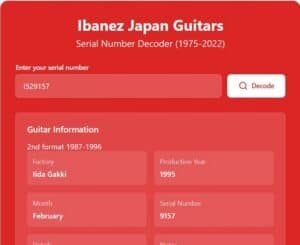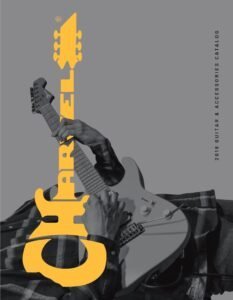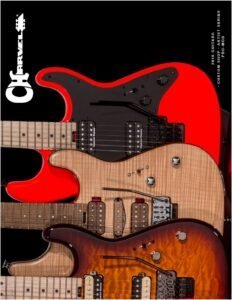Last Modified : Saturday, December 30th, 2023
When discussing Japanese vintage guitars, the focus often shifts to instruments produced primarily in the ’70s, ’80s, or even the ’90s. However, many Japanese guitar manufacturers crafted instruments before the ’70s, usually with unique designs. These early instruments often bore shapes influenced by major brands like Gibson, Fender, Mosrite, Burns, Vox, and others, although they weren’t yet refined copies.
Among the pioneers in creating high-quality replicas in Japan were Greco guitars, distributed by Kanda Shokai Corporation. Established in 1948, Kanda Shokai is a prominent distributor of musical instruments. They introduced Greco to the market in 60’s.
The Beatles’ 1966 tour in Japan significantly impacted Greco’s projects, prompting the launch of a Fender Telecaster replica with a solid body and a Hofner bass replica sporting a violin-bass design.
In 1969, the British band Led Zeppelin sparked a transformative period in Greco guitar production. Led Zeppelin released two seminal albums (Led Zeppelin I and II), where guitarist Jimmy Page significantly popularized the iconic Gibson Les Paul Standard with a Sunburst finish. This period witnessed Japanese youth longing to acquire Gibson Les Paul Customs, SGs, Fender Stratocasters, Telecasters, and other guitar models.
By 1970, the average salary for a recent university graduate in Japan stood at 43,000 yen (JYE). With the exchange rate around 360 yen for 1 US dollar, a young Japanese graduate’s initial salary was approximately $120. A new Stratocaster, priced at 239,000 yen, surpassed $660 in US dollars. This meant young enthusiasts had to save more than five months’ salary to purchase their dream guitars.
In 1971, Japan hosted tours by eminent bands such as Led Zeppelin, Pink Floyd, and Grand Funk Railroad. These events further motivated young individuals to aspire to their idols’ guitars, fueling a surge in Rock ‘n’ Roll enthusiasm. Greco quickly recognized the need to adapt to this evolving market and cater to the desires of the youth.
Given the steep prices of Gibson guitars in Japan, only a few jazz musicians could afford them, leaving Greco without genuine Gibson instruments. Consequently, Greco relied on catalog images and artists’ inputs to create a copie of the Gibson Les Paul (Greco EG series). The original EG-360 series differed from the authentic Les Paul in neck dimensions and body manufacturing. Nevertheless, these guitars bore enough resemblance to captivate the Japanese audience, marking the onset of a new era in the history of Made in Japan guitars.
As previously mentioned, Kanda Shokai mainly handled the marketing and distribution of guitars and basses produced by two subcontractors. These companies were Matsumoku Industrial Co. in the first half of the ’70s and Fujigen Gakki, which commenced around 1974-75 and continued until the ’90s. Fujigen manufactured Ibanez (for oversea market) and Greco instruments (for Japanese market), leading the Japanese to regard them as ‘twin brands’.
In the early 1970s, Greco asked Hidesato Shiino, who was officially working for Yamaha, to develop guitar production and to become a marketing consultant.
At first, Shiino was leading most guitar makers, not just Greco. He worked as a consultant for ELK, Guyatone, Fernandes and Kasuga among others.
He contacted his old friend Shigeru Narumo (1947-2007) who was then a well-known guitarist and grandson of the founder of Bridgestone Tire in Hatoyama, Mr. Yukio. Narumo began developing and supervising the production of Greco guitars with Shiino. They both advised Greco to make guitars whose quality would be superior to that of the Gibson Les Paul for a more accessible price and with a thiner neck so that it is better adapted to the hands of the Japanese.
Shiino oversaw the manufacture of a guitar prototype for Narumo according to the specifications they had determined. The guitar was made in a few days and Narumo was very pleasantly surprised by the new EG Custom. All Narumo musicians tested a Gibson, a Fender and the new Greco and all agreed that the EG was the best!
Narumo played in his concerts with the new EG-360 Custom and his Gibson. The Japanese audience was surprised to see that a Japanese guitar was just as good, if not better, than the original.
The only thing that Narumo did not really like was that Greco was based on a photo of Paul Kossoff (of the Free rock band), provided by Narumo himself, to replicate the color of the prototype. Kossoff was playing on a No. 2 Gibson whose finish was in brown sunburst, but Greco could not check the color on the back of the guitar … They had done a sunburst finish on the back and on the neck.
Narumo’s involvement in this project and these live performances have resulted in a huge increase in Greco’s sales. The brand had therefore asked Narumo to endorse him exclusively. A little reluctant at first, Narumo saw a chance to make the guitars he dreamt of. During a visit to the Fujigen factory, Narumo suggested leaving the humbucker pickups of the bridge open and profiling the shape of the back like a Stratocaster. His suggestions gave birth to the EG-420, which proved superior to the EG-360.

Following the EG-420, Greco and Narumo embarked on a collaboration that gave rise to various model creations and enhancements. Their notable joint effort culminated in the EG-800, largely influenced by Narumo’s vision. Retaining the EG-420’s back contour, the EG-800 featured superior quality woods and open humbuckers. Unlike the semi-hollow and six-piece mahogany pancake body of the EG-420, the EG-800 boasted a two-piece maple top, an ebony fingerboard, and a set neck—a feature that later became a Greco standard.
Officially, Narumo claimed no involvement with the EG-800’s development, stating that his role concluded with the EG-700 prototype, and he only learned of the EG-800 years later. However, the EG-800’s distinct characteristics strongly imply its inspiration from Narumo’s suggestions.
During the mid-1970s, Greco significantly amplified its production of replicas. Kanda Shokai, then importing Gibson USA, urged Fujigen (producer of Greco and Ibanez) to focus on increasing replica production. This period marked the inception of the famous ‘lawsuit guitars’ as Ibanez began saturating the American market.
In 1972, Greco introduced Custom Shop guitars at the behest of Bad Company’s guitarist Mick Ralphs, who expressed a desire for a Custom Greco during a visit to a Kanda Shokai workshop. This led to the creation of the ‘MR’ model, followed by replicas of instruments like Paul McCartney’s Rickenbacker and Brian May’s guitar.
Toward the late 1970s, Greco developed the ‘GO’ series featuring a neck-through design, complicating the installation of pots and switches.
This new GO series garnered widespread acclaim among guitarists. Kanda Shokai launched TV ads and endorsed numerous Japanese guitarists, contributing to the series’ commercial success. Subsequently, Kanda introduced the ‘GO-II,’ ‘GO-III,’ and ‘Mirage’ series, all achieving significant popularity.
Between 1980 and 1982, Kanda made substantial investments in the Greco Super Real series. Notably, the EGF-1000 model was hailed by many in Japan as superior to Gibson. The choice of superior-quality wood surpassed that used by Gibson or Fender for their models. Hardware was meticulously redesigned to closely mirror the originals found on the Gibson Les Paul. Greco introduced the renowned Z-DRY humbucker pickups, featured in the EGF-1200 and EGF-1800 models (while the EGF-850 had PU-2 pickups, and the EGF-1000 used Dimarzio PAFs).
In 1981, Kanda initiated discussions with Fender USA and Yamano to establish Fender Japan. Consequently, the Super Real Stratocaster SE-1200 was the final Stratocaster copy designed by Greco. After nearly a decade of producing Stratocaster replicas starting in 1973, Greco concluded this chapter in 1982. This pivotal moment marked a significant transition for Greco while heralding a new chapter in Fender’s history with its Made in Japan models.
During the 80s and 90s, Greco encountered challenges. The brand shifted focus from producing replicas of Fender and Gibson guitars as Gibson introduced its “Orville by Gibson” line. Consequently, Greco redirected efforts towards creating original guitars, diminishing their production of Gibson replicas.
Presently, Greco still operates under the name Greco-Zemaitis guitars. Kanda Shokai holds numerous licenses for international brands, including Zemaitis, which manufactures high-end guitars labeled as Zemaitis by High-End and Greco-Zemaitis by Tokai.
In 2012, Kanda Shokai initiated the production of new Greco guitars. These models, while often drawing inspiration from American brand guitars, showcase significant design differences, setting them apart from direct copies of Gibson, Fender, or other established brands.
Source: www.music-trade.co.jp
Greco Serial Number Decoder & Models
Wait for Decoder Loading … × Before 1975, Greco guitars...
Read MoreGreco Pickups made by Maxon (Nisshin Onpa)
Last Updated : December 30, 2023 Greco guitars typically feature...
Read MoreGreco: Super Real collection
In 1980, specifically toward the end of 1979, Greco departed...
Read MoreGreco: Mint collection
In 1982, the ‘Super Real’ collection was succeeded by the...
Read More




















13 Responses
Love your article very informative, thankyou.
Thank you Lori! You’re welcome. 🙂
Superb, thank you very much for researching and posting this. I too am a huge fan, and when I can, collector of these classic instruments. Thank you again for your blog ????????
Great article… I have what I believe to be a 1968 or 69 Greco 920 Pro 2 pickup with Vibrato in Walnut with the original case. I don’t see these fine hollow body guitars mentioned in your article. Can you point me to more info on these guitars and this period of Greco production. Specifically what years did Greco produce the 920’s and were they hand made in the MatsuMoku facility?
Thanks – Kelly
Hello Kelly,
about the period of production, you can take a look at late 60’s the catalogs on this blog.
Hi great article, I am trying to find out if greco factory’s ever made kirby guitars?
Greco guitars are made by Fujigen. I don’t know about Kirby brand.
Thanks Frankie for the informative article, I enjoyed it!
I’ve read that Greco started moving production to Korea at some point. I have a 1988 Mint Collection Greco LP Junior – is there a way to tell if examples during this period were still made in Japan?
If there is a serial number then it’s a Fujigen made guitar. No serial number indicate that it can be Tokai (Japan) or Cort (Korea). Difference between Tokai and Cort made guitars can be established with nuts, logo, tuners, etc that are different.
Thanks for that information Frankie, I’m looking at a Greco Howard Roberts, it looks very similar to the Ibanez model of the same name, would they have both been made in the same Japanese factory?
Many thanks
Jeff
Nice website Frankie, thank you – I own a ‘Jumbo JP-38’ archtop by Ryohei Tahara (Jumbo Musical Instrument Gakki, 1969 -’76) – almost no trace of these on the Internet (I searched for months and only ever found trace of 2, same model as mine but sold years earlier). Yet a (c.69/’70?) ‘Jumbo’ catalogue listed 8 archtop models, 2 being photographed). So…….where have they all disappeared to? are they all in humidity-controlled Japanese collectors’ museums ? – or besides the JP-38 models, were those other models ever made at all ? – only person who might know is perhaps Mr Tahara’s then-apprentice Mr Eichii Sumi – I think he now heads up a ‘Sumi Guitars’ custom shop in Japan………any info, anyone ?
Good morning here, Man I just got on trade a 1989 Greco RS1000 in purple. Serial number 9 7134. This hollow play looks and sounds so awesome. Ive been trading guitars for years never run across anything like this before. Tortise shell binding, cool block inlays gold hardware, This guitar sreams top notch quality. I read somewhere after this production model Gibson created the ES-137. Copied them! The more research I do I know I want one of the Les Pauls now. AMAZING FIND
Hello, I just purchased a Greco L-10P Archtop guitar. It is a small full hollow body with a single neck pickup. I think the body, top, back and neck are all made of solid mahogany (but can’t really be sure). There is not much info available about the L series Greco’s. Your serial number app doesn’t work with C028322 but I assume it is made in March 2002?